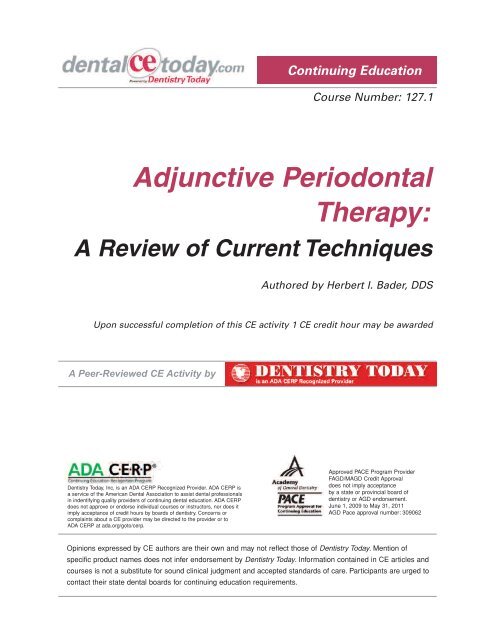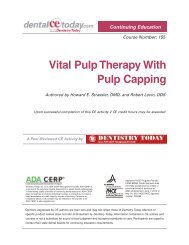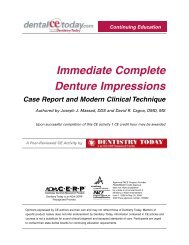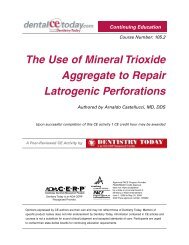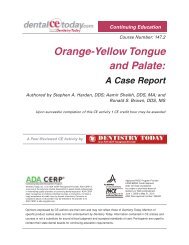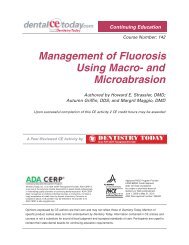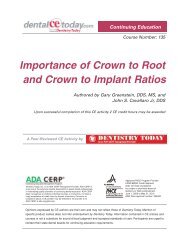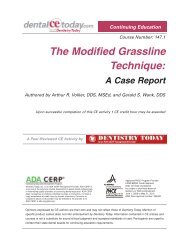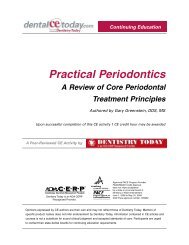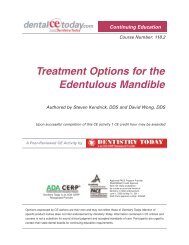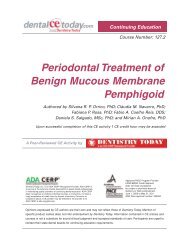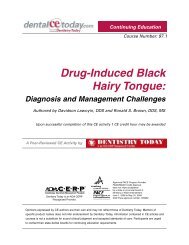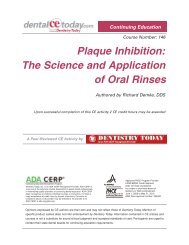Adjunctive Periodontal Therapy: A Review of ... - DentalCEToday
Adjunctive Periodontal Therapy: A Review of ... - DentalCEToday
Adjunctive Periodontal Therapy: A Review of ... - DentalCEToday
- No tags were found...
You also want an ePaper? Increase the reach of your titles
YUMPU automatically turns print PDFs into web optimized ePapers that Google loves.
Continuing EducationCourse Number: 127.1<strong>Adjunctive</strong> <strong>Periodontal</strong><strong>Therapy</strong>:A <strong>Review</strong> <strong>of</strong> Current TechniquesAuthored by Herbert I. Bader, DDSUpon successful completion <strong>of</strong> this CE activity 1 CE credit hour may be awardedA Peer-<strong>Review</strong>ed CE Activity byDentistry Today, Inc, is an ADA CERP Recognized Provider. ADA CERP isa service <strong>of</strong> the American Dental Association to assist dental pr<strong>of</strong>essionalsin indentifying quality providers <strong>of</strong> continuing dental education. ADA CERPdoes not approve or endorse individual courses or instructors, nor does itimply acceptance <strong>of</strong> credit hours by boards <strong>of</strong> dentistry. Concerns orcomplaints about a CE provider may be directed to the provider or toADA CERP at ada.org/goto/cerp.Approved PACE Program ProviderFAGD/MAGD Credit Approvaldoes not imply acceptanceby a state or provincial board <strong>of</strong>dentistry or AGD endorsement.June 1, 2009 to May 31, 2011AGD Pace approval number: 309062Opinions expressed by CE authors are their own and may not reflect those <strong>of</strong> Dentistry Today. Mention <strong>of</strong>specific product names does not infer endorsement by Dentistry Today. Information contained in CE articles andcourses is not a substitute for sound clinical judgment and accepted standards <strong>of</strong> care. Participants are urged tocontact their state dental boards for continuing education requirements.
Continuing Education<strong>Adjunctive</strong> <strong>Periodontal</strong> <strong>Therapy</strong>: A <strong>Review</strong> <strong>of</strong> Current Techniquespovidone iodine and others, especially the class <strong>of</strong>nonsteroidal anti-inflammatory drugs, can be useful whenapplied topically. 17-20ANTIMICROBIAL THERAPYLocal: Over the past 3 decades a number <strong>of</strong> sustainedrelease, anti-infective, site-specific vehicles have beendeveloped as a means <strong>of</strong> improving the efficacy <strong>of</strong> SRP interms <strong>of</strong> pocket depth reduction, attachment gain, andinflammatory reduction. Subsequent to Goodson, et al’swork 21,22 with tetracycline impregnated ethylene acetatefibers, a variety <strong>of</strong> second generation applications wereintroduced in the late 1990s, all <strong>of</strong> which are biodegradableand do not have to be removed from the site <strong>of</strong> placement.In 1998, Astra Pharmaceuticals introduced PerioChip, a4 x 5 mm degradable chip in a gelatin matrix, containing 2.5mg <strong>of</strong> CHX gluconate (Figure 2). The device was approvedfor room temperature storage in 2002. It remains in thepocket for 7 to 10 days, slowly releasing the antiseptic (40%initially), 23 and is fully biodegradable. It may be placedevery 3 months in residual pockets <strong>of</strong> 5 mm or more indepth. There are numerous published studies on efficacy,showing some gain in attachment level and pocket depthreduction as compared to SRP alone, along with somereduction in inflammatory mediators. 24 The magnitude <strong>of</strong>change <strong>of</strong> probing depth and attachment gain has beendemonstrated to average about 0.3 mm. 25-28 It has beenshown to be safe with minimal untoward side effects, and iseasily inserted into the pocket.The cost <strong>of</strong> the chips varies depending on the number<strong>of</strong> boxes purchased. Each box contains 20 chips at anaverage <strong>of</strong> $17.45 per chip. Generally, each surface <strong>of</strong> thetooth treated requires a single chip.In 1998, Atrix Laboratories introduced Atridox, athixotropic gel containing 10% doxycycline hyclate, a sitespecificantimicrobial adjunct to SRP. The term “thixotropic”refers to the product’s conversion from a gel to a hard,plastic state when it comes in contact with moisture in thepocket. This allows the antibiotic-containing material toremain in place for 7 to 21 days. The flowable nature <strong>of</strong> thegel allows for the entire defect to be filled with the agent.Atridox is packaged in 2 syringes, which are mixedabFigures 1a and 1b.Site-specific application<strong>of</strong> chlorhexidine (CHX).Figure 2.PerioChip (AstraPharmaceuticals), a4 x 5 mm degradablechip in a gelatin matrix.Figure 3a.Atridox syringes.Figure 3b.Atridox being introducedinto pocket.2
thoroughly and then introduced into the pocket witha disposable cannula (Figures 3a and 3b). Eachsyringe contains enough material to treat 5 to 6sites, making it a very cost effective approach toisolated residual pockets remaining after SRP. A box<strong>of</strong> 6 applications averages about $11.38 per site.There is considerable evidence supporting theefficacy <strong>of</strong> Atridox. The report by Polson andcolleagues 29 on the initial clinical response to asubgingival, biodegradable doxycycline system in1996 was an early study <strong>of</strong> clinical relevance.Perhaps the most interesting initial studies weremulticenter, 3-armed protocols in which Atridox wascompared to SRP, placebo control, and oral hygiene,and found to be equally effective to SRP, and in asubsequent study was equally effective inmaintenance patients over a 9-month period. 30,31The system has been found to significantly reduce the anaerobicpathogens in the bi<strong>of</strong>ilm without an increase inresistant organisms or the development <strong>of</strong> antibioticresistance. 32 Figure 4 shows the effect on 2 criticalperiodontal pathogens over a 182-day period.A recent study 33 compared the effects <strong>of</strong> 3 local,sustained delivery systems: doxycycline hyclate 10%(Atridox), CHX gluconate 2.5 mg (PerioChip), andminocycline hydrochloride 1 mg (Arestin) on osteoblasticcell proliferation and differentiation, in terms <strong>of</strong> periodontalregeneration. The doxycycline hyclate did not have thecytotoxic effect exhibited by the 2 other agents, and in fact,appeared to enhance maturation and differentiation. Theauthors 33 suggested that doxycycline hyclate may have anadditional benefit other than its antimicrobial effect, andmay help enhance periodontal regeneration.The development <strong>of</strong> a technique for microencapsulatingminocycline hydrochloride in a bioabsorbablepolymer for site-specific subgingival delivery resulted in theintroduction <strong>of</strong> Arestin in 2001. The system’spharmacokinetics results in gradual hydrolyzation <strong>of</strong> themicrospheres with sustained release over 14 days. It isdelivered with disposable tips in a sterilizable syringe(Figures 5 and 6).A large 18-site, multicenter study reported that SRP plusContinuing Education<strong>Adjunctive</strong> <strong>Periodontal</strong> <strong>Therapy</strong>: A <strong>Review</strong> <strong>of</strong> Current TechniquesEffect <strong>of</strong> Atridox on Red Complex BacteriaSample Period (Days)Atridox treatment significantly reduced 2 <strong>of</strong> the most prevalent pathogens associatedwith periodontal disease (Porphyrmonas gingivalis and Bacteriodes forsythus[Tannellera forsythia]) and sustained the effect after 6 months.Data on File Tolmar, Inc.Figure 4. Effect on red complex from Walker CB, et al. 32Figure 5. Arestin delivery system.Figure 6.Arestin application.minocycline microspheres was more effective than SRPalone in reducing pocket depths in periodontitis patients. 343
Continuing Education<strong>Adjunctive</strong> <strong>Periodontal</strong> <strong>Therapy</strong>: A <strong>Review</strong> <strong>of</strong> Current TechniquesThis confirmed some <strong>of</strong> thefindings from an earlier, wellcontrolled study. 35Other reports in theliterature attest to improvementin clinical parameters whenusing minocycline microspheresin addition to SRP. Theseinclude evidence that it can bean aid in peri-implantitis and improvingsurgical outcomes. 36-39Arestin is packaged in 2 foilwraps per box, each containing12 disposable tips, for anaverage cost <strong>of</strong> $19.98 perapplication.A thorough review <strong>of</strong> localdrug delivery, also called locallyapplied antibiotics, by Greenstein 13 suggests that whilelocally delivered agents have demonstrated clinical efficacy,they are not panaceas, and their use is based on clinicaldecisions taking into account the patient’s specific clinicalsituation. It is generally agreed that due to the nature <strong>of</strong>subgingival plaque bi<strong>of</strong>ilm, it must be disrupted byinstrumentation prior to the use <strong>of</strong> antimicrobials.SYSTEMIC ANTIMICROBIALSThe literature on the use <strong>of</strong> systemic antimicrobials is quiteextensive, and much <strong>of</strong> the current use <strong>of</strong> this modality isbased on the seminal works by Haffajee, Socransky, Teles,and others. 8,40-44 Antibiotics have been used for manyyears based on the accumulated evidence <strong>of</strong> periodontitisbeing an infectious disease, 44 as an adjunct to improve theresults <strong>of</strong> SRP. The AAP’s position on systemic antibioticsis: “They may be prescribed for periodontal patients who donot respond to conventional mechanical therapy, forpatients with acute periodontal infections associated withsystemic manifestations, for prophylaxis in medicallycompromised patients, and as an adjunct to surgical andnonsurgical periodontal therapy.” 45 Of the hundreds <strong>of</strong>bacterial species identified within periodontal pockets,relatively few have been associated with chronicTable 1. Pathogenicity <strong>of</strong> bacterial species in periodontalpockets [From: Hafajjee and Socransky, 44 and Slots and Chen 46 ]Very Strong Strong Moderate IndeterminatePorphyrmonas Prevotella Campylobacter Gram-enteric rodsgingivalis intermedia rectusAggregatibacter Eubacterium Peptostreptococcus Pseudomonas speciesactinomycetimcomitans nodatum microsTannerella forsythia Treponema Fusobacterium Staphylococcus speciesdenticola nodatumSpirochetes <strong>of</strong> acute Dialister Eikenella Enterococcus faecalisnecrotizing gingivitis species corrodensSelenomonas noxiaBeta-hemolyticstreptococciCandida albicansperiodontitis, and the weight <strong>of</strong> evidence relative to theirpathogenicity has been described (Table 1). 44,46Based on the susceptibility to various antibiotics andantibiotic combinations, a number <strong>of</strong> different strategies havebeen developed for adjunctive systemic antimicrobialuse. 8,47-50 The most commonly used antibiotics, asdescribed by the AAP paper, 45 are seen in Table 2. Again,they are selected according to bacterial susceptibility. A DNApolymerasechain reaction has been marketed (MyPerioPath[OralDNA Labs]) which provides a clinical laboratory reporton 13 pathogens based on salivary testing, 51 and can beused as a guide for antibiotic selection based on the patient’speriodontal status and medical and family history.As is the case with local antibiotic administration, it isessential that the bi<strong>of</strong>ilm be disrupted initially before theadministration <strong>of</strong> systemic antibiotics.HOST MODULATIONGiven the protective aspects <strong>of</strong> the host immune system in theperiodontal patient, 3 a major thrust in research for more than2 decades has been aimed at modulating or amelioratingthe release <strong>of</strong> proinflammatory cytokines such as thematrix metalloproteinases. 52,53 As a result <strong>of</strong> this work, asubantimicrobial dose doxycycline regimen has been in use for4
Continuing Education<strong>Adjunctive</strong> <strong>Periodontal</strong> <strong>Therapy</strong>: A <strong>Review</strong> <strong>of</strong> Current TechniquesTable 2. Commonly used antibiotics and dosagesAntibiotic Metronidazole Amoxicillin Tetracycline Cipr<strong>of</strong>loixacin Azithromycin Clindamycin ClarithromycinDoses 500 mg twice a 250 to 500 100 to 200 500 mg 250 to 500 300 mg 500 mg 2day or 3 times mg 3 times mg once 2 times mg once 3 times times a daya day a day a day a day a day a day oronce a dayTime (days) 8 to 10 8 to 10 8 to 14 8 to 10 5 (Z-pack) 8 8some time. Periostat (doxycycline hyclate 20 mg) is given twicedaily to inhibit host-derived matrix metalloproteinases (MMPs),including the collagenases. These results have no relation tothe antimicrobial action <strong>of</strong> the drug, and in fact, areadministered at levels below that which causes bacteriostasis.By acting to down-regulate the expression <strong>of</strong> the MMPs andtheir precursors, the collagen-building block <strong>of</strong> the periodontalconnective tissues are spared. 54A seminal study on the combined effects <strong>of</strong> hostmodulation and local antibiotic therapy was published in2008. 55 The inclusion <strong>of</strong> SRP along with Atridox doxycyclinethixotropic gel, and systemic low dose doxycline hyclate, wasshown to provide significantly greater clinical benefits thanSRP alone, perhaps as a result <strong>of</strong> synergistic actions <strong>of</strong> theadjunctive antimicrobials.There continues to be a large body <strong>of</strong> ongoing research onvarious forms <strong>of</strong> host modulating therapy. 56 Research extendsinto inhibition <strong>of</strong> osteoclasts with bone sparing agents such asbisphosphonates and cathepsins, 57 affecting prostaglandinformation. 58 With a greater understanding <strong>of</strong> the sequence <strong>of</strong>events related to inflammation and its resolution, researchersare beginning to look at drugs that may have been heret<strong>of</strong>oreoverlooked. 59ADJUNCTIVE LASER THERAPYA number <strong>of</strong> different types <strong>of</strong> laser engines have been usedin dentistry for many years, and published papers haveexhibited some controversy 60 over usefulness in adjunctivetreatment <strong>of</strong> periodontitis. A review <strong>of</strong> the literature byCobb, 61 commissioned by the AAP, is very comprehensiveon this subject. There is current evidence as to the positiveeffect <strong>of</strong> the Nd:YAG and Er:YAG lasers in reducing probingdepths and altering the subgingival microbiota, 61 and recentwork by Yukna, et al 62,63 describe the laser assisted newattachment procedure with promising results.Photodynamic laser therapy (PDT) is another adjunctivelaser approach that is receiving much attention. PDT isbased on the principle that a photosensitizer (methyleneblue, phenothiazine, tolamine chloride [TBlue; Zila]) isabsorbed onto the surface <strong>of</strong> the target cell (Gram-negativepathogens), is activated by a diode laser (660 nmwavelength), and is then toxic to the cell. While there isevidence that there is a reduction in inflammatory mediators(TNF-alpha, and crevicular RANKL), the effects are similar toSRP in order <strong>of</strong> magnitude. 64It is generally agreed that more detailed, controlledclinical research studies are necessary, especially long-termdesigns looking at clinical outcomes, for complete validation<strong>of</strong> this form <strong>of</strong> adjunctive therapy.SUMMARYThis paper has reviewed the different types <strong>of</strong> adjunctivetherapeutic approaches used in the control <strong>of</strong> periodontitis.While there are many avenues <strong>of</strong> current clinical use andresearch, it is generally agreed that all <strong>of</strong> the modalities reviewedare adjunctive to basic mechanical control <strong>of</strong> the root surfaceenvironment in the form <strong>of</strong> SRP.5
Continuing Education<strong>Adjunctive</strong> <strong>Periodontal</strong> <strong>Therapy</strong>: A <strong>Review</strong> <strong>of</strong> Current TechniquesREFERENCES1. Haffajee AD, Socransky SS. Introduction to microbialaspects <strong>of</strong> periodontal bi<strong>of</strong>ilm communities, developmentand treatment. Periodontol 2000. 2006;42:7-12.2. Loe H, Theilade E, Jensen SB. Experimental gingivitisin man. J Periodontol. 1965;36:177-187.3. Page RC, Kornman KS. The pathogenesis <strong>of</strong> humanperiodontitis: an introduction. Periodontol 2000.1997;14:9-11.4. Page RC, Offenbacher S, Schroeder HE, et al.Advances in the pathogenesis <strong>of</strong> periodontitis: summary<strong>of</strong> developments, clinical implications and futuredirections. Periodontol 2000. 1997;14:216-248.5. Drisko CH. Nonsurgical periodontal therapy.Periodontol 2000. 2001;25:77-88.6. Tagge DL, O’Leary TJ, El-Kafrawy AH, et al. Theclinical and histological response <strong>of</strong> periodontal pocketsto root planing and oral hygiene. J Periodontol.1975;46:527-533.7. Drisko CL, Cochran DL, Blieden T, et al. Research,Science and <strong>Therapy</strong> Committee <strong>of</strong> the AmericanAcademy <strong>of</strong> Periodontology. Position paper: sonic andultrasonic scalers in periodontics. J Periodontol.2000;71:1792-1801.8. Haffajee AD, Teles RP, Socransky SS. The effect <strong>of</strong>periodontal therapy on the composition <strong>of</strong> thesubgingival microbiota. Periodontol 2000.2006;42:219-258.9. Cobb CM. Non-surgical pocket therapy: mechanical.Ann Periodontol. 1996;1:443-490.10. Jolkovsky DL, Waki MY, Newman MG, et al. Clinicaland microbiological effects <strong>of</strong> subgingival and gingivalmarginal irrigation with chlorhexidine gluconate.J Periodontol. 1990;61:663-669.11. Ciancio SG, Mather ML, Zambon JJ, et al. Effect <strong>of</strong> achemotherapeutic agent delivered by an oral irrigationdevice on plaque, gingivitis, and subgingival micr<strong>of</strong>lora.J Periodontol. 1989;60:310-315.12. Newman MG, Cattabriga M, Etienne D, et al.Effectiveness <strong>of</strong> adjunctive irrigation in earlyperiodontitis: multi-center evaluation. J Periodontol.1994;65:224-229.13. Greenstein G; Research, Science and <strong>Therapy</strong>Committee <strong>of</strong> the American Academy <strong>of</strong> Periodontology.Position paper: The role <strong>of</strong> supra- andsubgingival irrigation in the treatment <strong>of</strong> periodontaldiseases. J Periodontol. 2005;76:2015-2027.14. Al-Mubarak S, Ciancio S, Aljada A, et al. Comparativeevaluation <strong>of</strong> adjunctive oral irrigation in diabetics.J Clin Periodontol. 2002;29:295-300.15. Bader HI, Williams RC. Chlorhexidine efficacyenhancement by local application with powered rotarydevice. J Dent Res (abstract). January 1992.16. Bader HI, Williams RC. Rotary powered brushing withchlorhexidine compared to manual brushing plusirrigation. J Dent Res (abstract). January 1994.17. Paquette DW, Rosenberg A, Lohinai Z, et al.Inhibition <strong>of</strong> experimental gingivitis in beagle dogswith topical mercaptoalkylguanidines. J Periodontol.2006;77:385-391.18. Johannsen A, Tellefsen M, Wikesjö U, et al. Localdelivery <strong>of</strong> hyaluronan as an adjunct to scaling and rootplaning in the treatment <strong>of</strong> chronic periodontitis.J Periodontol. 2009;80:1493-1497.19. Van Dyke TE, Cutler CW, Kowolik M, et al. Effect <strong>of</strong>topical cimetidine rinse on gingival crevicular neutrophilleukocyte function. J Periodontol. 2005;76:998-1005.20. Howell TH, Fiorellini J, Weber HP, et al. Effect <strong>of</strong> theNSAID piroxicam, topically administered, on thedevelopment <strong>of</strong> gingivitis in beagle dogs. J <strong>Periodontal</strong>Res. 1991;26(3 pt 1):180-183.21. Goodson JM, Hogan PE, Dunham SL. Clinicalresponses following periodontal treatment by local drugdelivery. J Periodontol. 1985;56(suppl 11):81-87.22. Goodson JM, Cugini MA, Kent RL, et al. Multicenterevaluation <strong>of</strong> tetracycline fiber therapy: I. Clinicalresponse. J <strong>Periodontal</strong> Res. 1991;26:371-379.23. Soskolne WA, Heasman PA, Stabholz A, et al. Sustainedlocal delivery <strong>of</strong> chlorhexidine in the treatment<strong>of</strong> periodontitis: a multi-center study. J Periodontol.1997;68:32-38.24. Jeffcoat MK, Bray KS, Ciancio SG, et al. <strong>Adjunctive</strong> use<strong>of</strong> a subgingival controlled-release chlorhexidine chipreduces probing depth and improves attachment levelcompared with scaling and root planing alone.J Periodontol. 1998;69:989-997.25. Jeffcoat MK, Palcanis KG, Weatherford TW, et al. Use<strong>of</strong> a biodegradable chlorhexidine chip in the treatment<strong>of</strong> adult periodontitis: clinical and radiographic findings.J Periodontol. 2000;71:256-262.6
Continuing Education<strong>Adjunctive</strong> <strong>Periodontal</strong> <strong>Therapy</strong>: A <strong>Review</strong> <strong>of</strong> Current Techniques26. Grisi DC, Salvador SL, Figueiredo LC, et al. Effect <strong>of</strong> acontrolled-release chlorhexidine chip on clinical andmicrobiological parameters <strong>of</strong> periodontal syndrome.J Clin Periodontol. 2002;29:875-881.27. Azmak N, Atilla G, Luoto H, et al. The effect <strong>of</strong>subgingival controlled-release delivery <strong>of</strong> chlorhexidinechip on clinical parameters and matrixmetalloproteinase-8 levels in gingival crevicular fluid.J Periodontol. 2002;73:608-615.28. Carvalho J, Novak MJ, Mota LF. Evaluation <strong>of</strong> the effect<strong>of</strong> subgingival placement <strong>of</strong> chlorhexidine chips as anadjunct to scaling and root planing. J Periodontol.2007;78:997-1001.29. Polson AM, Southard GL, Dunn RL, et al. <strong>Periodontal</strong>pocket treatment in beagle dogs using subgingivaldoxycycline from a biodegradable system. I. Initialclinical responses. J Periodontol. 1996;67:1176-1184.30. Garrett S, Johnson L, Drisko CH, et al. Two multi-centerstudies evaluating locally delivered doxycycline hyclate,placebo control, oral hygiene, and scaling and rootplaning in the treatment <strong>of</strong> periodontitis. J Periodontol.1999;70:490-503.31. Garrett S, Adams DF, Bogle G, et al. The effect <strong>of</strong>locally delivered controlled-release doxycycline orscaling and root planing on periodontal maintenancepatients over 9 months. J Periodontol. 2000;71:22-30.32. Walker CB, Godowski KC, Borden L, et al. The effects<strong>of</strong> sustained release doxycycline on the anaerobic floraand antibiotic-resistant patterns in subgingival plaqueand saliva. J Periodontol. 2000;71:768-774.33. Almazin SM, Dziak R, Andreana S, et al. The effect<strong>of</strong> doxycycline hyclate, chlorhexidine gluconate,and minocycline hydrochloride on osteoblasticproliferation and differentiation in vitro. J Periodontol.2009;80:999-1005.34. Paquette DW, Hanlon A, Lessem J, et al. Clinicalrelevance <strong>of</strong> adjunctive minocycline microspheres inpatients with chronic periodontitis: secondary analysis<strong>of</strong> a phase 3 trial. J Periodontol. 2004;75:531-536.35. Williams RC, Paquette DW, Offenbacher S, et al.Treatment <strong>of</strong> periodontitis by local administration <strong>of</strong>minocycline microspheres: a controlled trial.J Periodontol. 2001;72:1535-1544.36. Lu HK, Chei CJ. Efficacy <strong>of</strong> subgingivally appliedminocycline in the treatment <strong>of</strong> chronic periodontitis.J <strong>Periodontal</strong> Res. 2005;40:20-27.37. Persson GR, Salvi GE, Heitz-Mayfield LJ, et al.Antimicrobial therapy using a local drug delivery system(Arestin) in the treatment <strong>of</strong> peri-implantitis. I:Microbiological outcomes. Clin Oral Implants Res.2006;17:386-393.38. Goodson JM, Gunsolley JC, Grossi SG, et al.Minocycline HCl microspheres reduce red-complexbacteria in periodontal disease therapy. J Periodontol.2007;78:1568-1579.39. Hellström MK, McClain PK, Schallhorn RG, et al. Localminocycline as an adjunct to surgical therapy inmoderate to severe, chronic periodontitis. J ClinPeriodontol. 2008;35:525-531.40. Teles RP, Haffajee AD, Socransky SS. Microbiologicalgoals <strong>of</strong> periodontal therapy. Periodontol 2000.2006;42:180-218.41. Haffajee AD, Socransky SS, Gunsolley JC. Systemicanti-infective periodontal therapy. A systematic review.Ann Periodontol. 2003;8:115-181.42. Wilson M. Susceptibility <strong>of</strong> oral bacterial bi<strong>of</strong>ilms toantimicrobial agents. J Med Microbiol. 1996;44:79-87.43. van Winkelh<strong>of</strong>f AJ, Rams TE, Slots J. Systemicantibiotic therapy in periodontics. Periodontol 2000.1996;10:45-78.44. Haffajee AD, Socransky SS. Microbial etiological agents<strong>of</strong> destructive periodontal diseases. Periodontol 2000.1994;5:78-111.45. Slots J; Research, Science and <strong>Therapy</strong> Committee <strong>of</strong> theAmerican Academy <strong>of</strong> Periodontology. Systemic antibioticsin periodontics. J Periodontol. 2004;75:1553-1565.46. Slots J, Chen C. The oral micr<strong>of</strong>lora and humanperiodontal disease. In: Tannock GW, ed. MedicalImportance <strong>of</strong> the Normal Micr<strong>of</strong>lora. London, England:Kluwer Academic Publishers; 1999:101-127.47. Herrera D, Alonso B, León R, et al. Antimicrobialtherapy in periodontitis: the use <strong>of</strong> systemicantimicrobials against the subgingival bi<strong>of</strong>ilm.J Clin Periodontol. 2008;35(suppl 8):45-66.48. Beikler T, Prior K, Ehmke B, et al. Specific antibiotics inthe treatment <strong>of</strong> periodontitis—a proposed strategy.J Periodontol. 2004;75:169-175.49. Brook I, Lewis MA, Sándor GK, et al. Clindamycin indentistry: more than just effective prophylaxis forendocarditis? Oral Surg Oral Med Oral Pathol OralRadiol Endod. 2005;100:550-558.7
Continuing Education<strong>Adjunctive</strong> <strong>Periodontal</strong> <strong>Therapy</strong>: A <strong>Review</strong> <strong>of</strong> Current Techniques50. Goodson JM. Antimicrobial strategies for treatment <strong>of</strong>periodontal diseases. Periodontol 2000. 1994;5:142-168.51. Bader HI. Antimicrobial aspects <strong>of</strong> inflammatorysuppression. Dent Today. 2009;28:142-145.52. Golub LM, Lee HM, Lehrer G, et al. Minocycline reducesgingival collagenolytic activity during diabetes. Preliminaryobservations and a proposed new mechanism <strong>of</strong> action.J <strong>Periodontal</strong> Res. 1983;18:516-526.53. Golub LM, Ramamurthy NS, McNamara TF, et al.Tetracyclines inhibit connective tissue breakdown: newtherapeutic implications for an old family <strong>of</strong> drugs. CritRev Oral Biol Med. 1991;2:297-321.54. Golub LM, Lee HM, Stoner JA, et al. Subantimicrobialdosedoxycycline modulates gingival crevicular fluidbiomarkers <strong>of</strong> periodontitis in postmenopausalosteopenic women. J Periodontol. 2008;79:1409-1418.55. Novak MJ, Dawson DR III, Magnusson I, et al.Combining host modulation and topical antimicrobialtherapy in the management <strong>of</strong> moderate to severeperiodontitis: a randomized multicenter trial.J Periodontol. 2008;79:33-41.56. Oringer RJ; Research, Science and <strong>Therapy</strong>Committee <strong>of</strong> the American Academy <strong>of</strong> Periodontology.Modulation <strong>of</strong> the host response inperiodontal therapy. J Periodontol. 2002;73:460-470.57. Giannobile WV. Host-response therapeutics forperiodontal diseases. J Periodontol. 2008;79(suppl8):1592-1600.58. Reddy MS, Geurs NC, Gunsolley JC. <strong>Periodontal</strong> hostmodulation with antiproteinase, anti-inflammatory, andbone-sparing agents. A systematic review. AnnPeriodontol. 2003;8:12-37.59. Bhatavadekar NB, Williams RC. New directions in hostmodulation for the management <strong>of</strong> periodontal disease.J Clin Periodontol. 2009;36:124-126.60. Karlsson MR, Diogo Löfgren CI, Jansson HM, et al.The effect <strong>of</strong> laser therapy as an adjunct to nonsurgicalperiodontal treatment in subjects with chronicperiodontitis: a systematic review. J Periodontol.2008;79:2021-2028.61. Cobb CM. Lasers in periodontics: a review <strong>of</strong> theliterature. J Periodontol. 2006;77:545-564.62. Yukna RA, Evans G, Vastardis S, et al. Humanperiodontal regeneration following the laser assistednew attachment procedure. J Dent Res. Abstract2411; 2004.63. Yukna RA, Carr RL, Evans GH, et al. Histologicevaluation <strong>of</strong> an Nd:YAG laser-assisted new attachmentprocedure in humans. Int J Periodontics RestorativeDent. 2007;27:577-587.64. de Oliveira RR, Schwartz-Filho HO, Novaes AB, et al.Antimicrobial photodynamic therapy in the non-surgicaltreatment <strong>of</strong> aggressive periodontitis: cytokine pr<strong>of</strong>ile ingingival crevicular fluid, preliminary results. JPeriodontol. 2009;80:98-105.8
Continuing Education<strong>Adjunctive</strong> <strong>Periodontal</strong> <strong>Therapy</strong>: A <strong>Review</strong> <strong>of</strong> Current TechniquesPOST EXAMINATION INFORMATIONTo receive continuing education credit for participation inthis educational activity you must complete the programpost examination and receive a score <strong>of</strong> 70% or better.Traditional Completion Option:You may fax or mail your answers with payment to DentistryToday (see Traditional Completion Information on followingpage). All information requested must be provided in orderto process the program for credit. Be sure to complete your“Payment,” “Personal Certification Information,” “Answers,”and “Evaluation” forms. Your exam will be graded within 72hours <strong>of</strong> receipt. Upon successful completion <strong>of</strong> the postexam(70% or higher), a letter <strong>of</strong> completion will be mailedto the address provided.Online Completion Option:Use this page to review the questions and mark youranswers. Return to dentalcetoday.com and sign in. If youhave not previously purchased the program, select it fromthe “Online Courses” listing and complete the onlinepurchase process. Once purchased the program will beadded to your User History page where a Take Exam linkwill be provided directly across from the program title.Select the Take Exam link, complete all the programquestions and Submit your answers. An immediate gradereport will be provided. Upon receiving a passing grade,complete the online evaluation form. Upon submitting theform your Letter Of Completion will be providedimmediately for printing.General Program Information:Online users may log in to dentalcetoday.com any time inthe future to access previously purchased programs andview or print letters <strong>of</strong> completion and results.POST EXAMINATION QUESTIONS1. The term “adjunctive therapy” is used to describe:a. Pocket reduction surgery.b. Ancillary or additional means <strong>of</strong> reducing the inflammatoryburden.c. Osseous regeneration using guided bone regeneration.d. Scaling and root planing.2. Topical application <strong>of</strong> anti-inflammatory agents hasbeen shown to be effective. These agents include:a. 0.12% chlorhexidine.b. Saline solution.c. Peroxide.d. Chloramphenicol.3. Second generation sustained release systems are:a. Antiseptics.b. Alcohol based.c. Biodegradable.d. Elastomeres.4. Periochip is an:a. Antibiotic.b. Antiseptic.c. Anti-inflammatory cytokine.d. Immune regulator.5. Atridox is doxycycline as a:a. Reversible colloid.b. Irreversible colloid.c. Thixotropic gel.d. Anionic gel.6. The American Academy <strong>of</strong> Periodontology states thatantibiotics may be prescribed for:a. Pocket depths greater than 5 mm.b. Use instead <strong>of</strong> SRP.c. Patients older than age 21 years.d. Nonresponsive patients.7. Host modulation refers to:a. Antimicrobial suppression.b. Altering a patient’s genotype.c. Altering the immune response.d. Eliminating the immune response.8. Current literature supports the use <strong>of</strong> lasers to:a. Regenerate bone.b. Reduce probing depths.c. Create osteotomies for implant placement.d. Increase anti-inflammatory matrix metalloproteinases.9
Continuing Education<strong>Adjunctive</strong> <strong>Periodontal</strong> <strong>Therapy</strong>: A <strong>Review</strong> <strong>of</strong> Current TechniquesPROGRAM COMPLETION INFORMATIONPERSONAL CERTIFICATION INFORMATION:If you wish to purchase and complete this activitytraditionally (mail or fax) rather than online, you mustprovide the information requested below. Please be sure toselect your answers carefully and complete the evaluationinformation. To receive credit you must answer at least 6 <strong>of</strong>the 8 questions correctly.Complete online at: dentalcetoday.comTRADITIONAL COMPLETION INFORMATION:Last Name (PLEASE PRINT CLEARLY OR TYPE)First NamePr<strong>of</strong>ession / CredentialsStreet AddressSuite or Apartment NumberLicense NumberMail or fax this completed form with payment to:Dentistry TodayDepartment <strong>of</strong> Continuing Education100 Passaic AvenueFairfield, NJ 07004Fax: 973-882-3622City State Zip CodeDaytime Telephone Number With Area CodeFax Number With Area CodeE-mail AddressPAYMENT & CREDIT INFORMATION:Examination Fee: $20.00 Credit Hours: 1.0Note: There is a $10 surcharge to process a check drawn onany bank other than a US bank. Should you have additionalquestions, please contact us at (973) 882-4700.❏ I have enclosed a check or money order.❏ I am using a credit card.My Credit Card information is provided below.❏ American Express ❏ Visa ❏ MC ❏ DiscoverANSWER FORM: COURSE #: 127.1Please check the correct box for each question below.1. ❏ a ❏ b ❏ c ❏ d 5. ❏ a ❏ b ❏ c ❏ d2. ❏ a ❏ b ❏ c ❏ d 6. ❏ a ❏ b ❏ c ❏ d3. ❏ a ❏ b ❏ c ❏ d 7. ❏ a ❏ b ❏ c ❏ d4. ❏ a ❏ b ❏ c ❏ d 8. ❏ a ❏ b ❏ c ❏ dPlease provide the following (please print clearly):Exact Name on Credit CardCredit Card #SignatureApproved PACE Program ProviderFAGD/MAGD Credit Approvaldoes not imply acceptanceby a state or provincial board <strong>of</strong>dentistry or AGD endorsement.June 1, 2009 to May 31, 2011AGD Pace approval number: 309062/Expiration DateDentistry Today, Inc, is an ADA CERP RecognizedProvider. ADA CERP is a service <strong>of</strong> the AmericanDental Association to assist dental pr<strong>of</strong>essionals inindentifying quality providers <strong>of</strong> continuing dentaleducation. ADA CERP does not approve or endorseindividual courses or instructors, nor does it implyacceptance <strong>of</strong> credit hours by boards <strong>of</strong> dentistry.Concerns or complaints about a CE provider may bedirected to the provider or to ADA CERP atada.org/goto/cerp.PROGRAM EVAUATION FORMPlease complete the following activity evaluation questions.Rating Scale: Excellent = 5 and Poor = 0Course objectives were achieved.Content was useful and benefited yourclinical practice.<strong>Review</strong> questions were clear and relevantto the editorial.Illustrations and photographs wereclear and relevant.Written presentation was informativeand concise.How much time did you spend readingthe activity and completing the test?10


